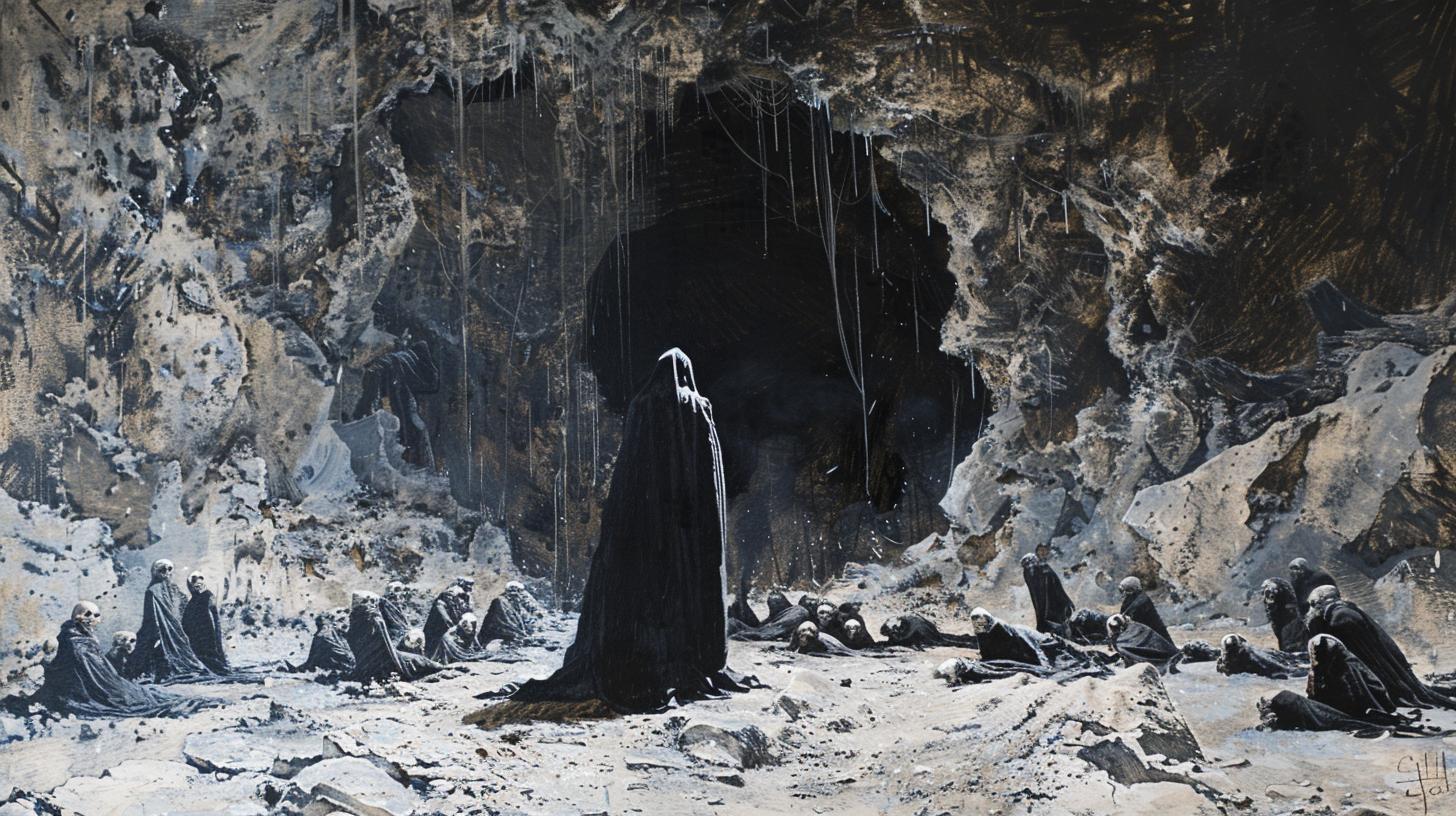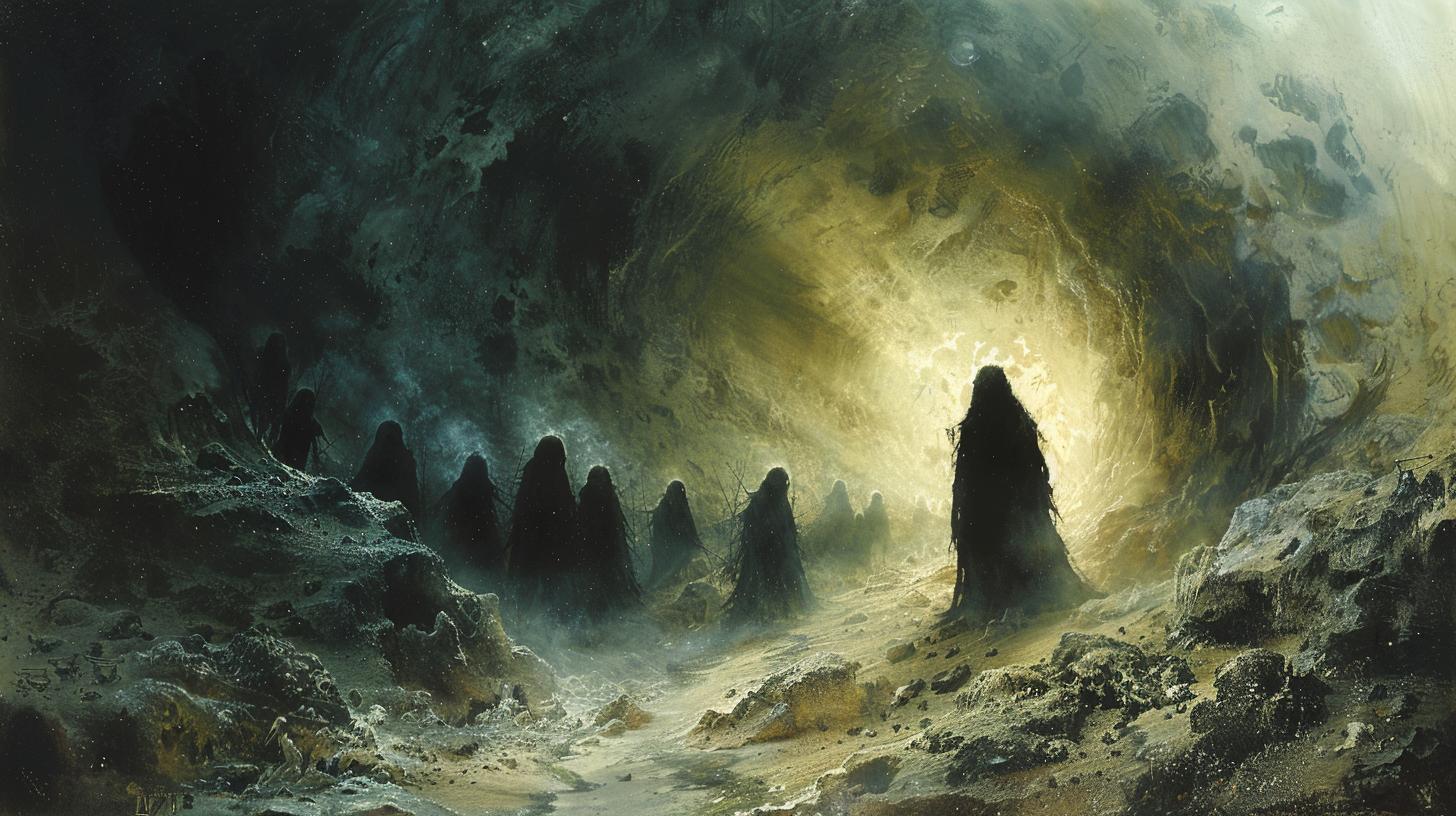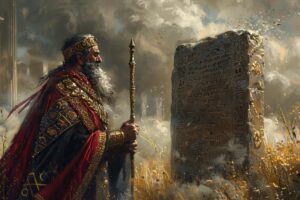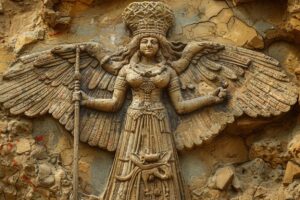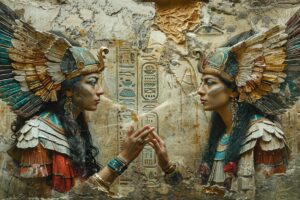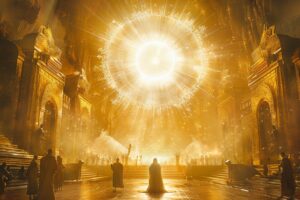Lelwani Goddess: From Male Deity to Female Power in Hittite Culture

Lelwani is a fascinating deity from the ancient Hattic and Hittite cultures. Initially worshiped as a male god, Lelwani’s role evolved significantly over time.
The deity later transformed into a female goddess, influenced by Hurrian religious practices and texts from the reign of Puduḫepa.
Origins and Early Representation
The origins and early representation of Lelwani trace a fascinating journey from a male deity in the Hattic civilization to its adoption and transformation within the Hittite pantheon.
Hattic Context
Lelwani as a Male Deity
In the Hattic culture, Lelwani was worshiped as a male god. He held significant roles and was primarily regarded as a sovereign of the underworld. The deity’s masculine identity is crucial to understanding its early reverence and functions.
Titles and Terms Used for Lelwani
Lelwani was referred to by noble titles such as ‘lord’ and ‘king.’ The terms ‘katte’ and ‘LUGAL-uš’ were commonly used, indicating his esteemed position in the Hattic religion. These titles emphasize the authority and high status Lelwani had among the Hattic gods.
Incorporation into Hittite Religion
Adoption by the Hittites
When the Hittites assimilated elements of the Hattic culture, Lelwani was integrated into their religious framework. This integration marked the continuation of Lelwani as a formidable ruler of the underworld within the Hittite belief system.
Early Hittite Depictions
Initial portrayals of Lelwani in Hittite religion retained the deity’s male characteristics and attributes. Artifacts and texts from this period reflect Lelwani’s continued worship as a powerful male figure overseeing the realm of the dead.
Gender Transformation of Lelwani
The evolution of Lelwani’s gender from male to female encapsulates profound cultural and religious shifts influenced primarily by Hurrian traditions.
Influence of Hurrian Religion
Syncretism with Hurrian Deities
As the Hittites came into contact with the Hurrians, their religious practices began to merge. The Hurrian pantheon, which included deities with roles similar to those in the Hittite belief system, significantly impacted the Hittite gods.
Lelwani, originally a male deity in Hattic culture, experienced a transformation due to the syncretism with Hurrian gods. The process of merging local deities with foreign ones was not uncommon, as it helped in the consolidation of power and religious uniformity.
Role of Hurrian Culture
Hurrian culture played a pivotal role in the gender transformation of Lelwani. The Hurrian influence brought a strong emphasis on female deities associated with the underworld. This cultural exchange led to the re-identification of Lelwani as a female entity.
The widespread acceptance of Hurrian traditions among the Hittites facilitated this gender transformation. By embracing aspects of Hurrian religion, the Hittites ensured that their own deities remained relevant and powerful.
Transition to a Female Deity
Evidence from Hittite Texts
The transition of Lelwani from male to female is well-documented in Hittite texts.
These texts highlight the changing perceptions and roles of Lelwani within Hittite society. References to Lelwani in these documents frequently describe the deity using female pronouns and attributes.
These textual sources are critical for understanding how religious syncretism influenced the gender identity of deities.
The transformation is indicative of broader theological and cultural adaptations by the Hittites.
References in the Reign of Puduḫepa
One significant source of evidence for Lelwani’s gender transformation comes from the reign of Queen Puduḫepa. In numerous texts associated with her, Lelwani is invoked as a goddess. Puduḫepa, a prominent figure in Hittite religion and politics, played a key role in promoting Lelwani’s new identity.
The references to Lelwani during this period are clear indicators of her importance and the acceptance of her female identity. These texts often involve prayers and rituals that highlight Lelwani’s attributes as a protective and benevolent deity.
Relationships with Other Deities
The study of Lelwani reveals significant associations with other deities, particularly within the Hittite and Hurrian pantheons.
Association with Allani
Lelwani had notable connections with Allani, the Hurrian goddess of the underworld. These associations emphasize the syncretic nature of ancient Anatolian religions, where deities from different cultures often merged or coexisted in the same religious framework.
Distinction from Ereshkigal
It is crucial to distinguish Lelwani from Ereshkigal, the Sumerian goddess of the underworld. While both deities were venerated in the Hittite religious texts, Ereshkigal maintained her separate identity.
This distinction underscores the complex layering of deities within the Hittite religious texts, where multiple foreign influences were integrated yet distinct roles were preserved.
Connections to Mesopotamian Gods
Lelwani’s integration into the Hittite pantheon also involved connections with various Mesopotamian gods. This indicates a cultural exchange that shaped the religious tapestry of ancient Anatolia.
Differentiation from Hurrian Ancestral Deities
While Lelwani was intertwined with Hurrian deities, it is important to differentiate Lelwani from the Hurrian ancestral deities, or “enna amatenna.”
These ancestral spirits had unique roles and were not directly equated with the underworld deities like Lelwani. This distinction helps in understanding the diverse religious practices that influenced Hittite worship.
Possible Synonyms in Hittite Texts
In Hittite texts, various names may refer to similar concepts or deities, reflecting the syncretic nature of Hittite religion. Terms like Allatum could sometimes be synonymous with Allani or Lelwani, creating a complex web of deity identifications.
This interweaving of names and roles demonstrates the fluidity of deity worship and the adaptability of religious practices in ancient Anatolia.
Functions and Attributes
The functions and attributes of Lelwani reflect the deity’s crucial roles in ancient Hittite and Hattic cultures, particularly in the context of the underworld and various protectorate functions.
Sovereign of the Underworld
Role in Judging Souls
Lelwani was primarily viewed as the sovereign of the underworld, responsible for judging the souls of the deceased.
This crucial role involved adjudicating the fates of individuals, making decisions regarding their afterlife journeys. The deity’s judgment was final, symbolizing the ultimate arbiter of divine justice. Texts often depict Lelwani as presiding over court-like settings in the underworld, highlighting the gravity and solemnity of this role.
Association with Fate
Lelwani’s association with fate extended beyond the afterlife. As a deity connected to the human lifespan, Lelwani was thought to oversee the destinies of humans from birth to death. This connection with the threads of fate emphasized the deity’s comprehensive power over life’s entire continuum.
Rituals often involved invoking Lelwani to ensure favorable destinies and outcomes, reflecting the belief in the deity’s ability to alter or control one’s predetermined path.
Secondary Functions
Protector in Military Campaigns
Beyond the underworld, Lelwani served as a protector in military campaigns. Historical records, particularly from the reign of Tudhaliya, indicate that Lelwani accompanied kings and warriors into battle, offering divine protection and ensuring victory.
This military aspect underscores the deity’s multifaceted nature, encompassing both protective and aggressive attributes. Invocations before battles often sought Lelwani’s favor to guarantee success and shield the warriors from harm.
Grantor of Long Life and Health
Lelwani was also associated with bestowing long life and health upon adherents.
Royalty and commoners alike prayed to Lelwani for these blessings, hoping to secure the deity’s favor for longevity and well-being. The deity’s influence in this domain is evident in numerous prayers and offerings dedicated to requesting sustained health and a prolonged life.
These rituals often formed part of broader ceremonies aiming to seek divine intervention for personal and communal prosperity.
Worship and Rituals
Festivals and rituals played a crucial role in the veneration of Lelwani, reflecting the cultural and religious dynamics of the Hittite society.
Festivals and Ceremonies
The Purulli Festival
The Purulli Festival was one of the most significant celebrations dedicated to Lelwani. This festival, rooted in Hattic tradition, marked the renewal of life in spring. Despite its focus on rebirth, it prominently featured deities of the underworld.
During the Purulli Festival, priests and worshippers offered sacrifices and performed rituals to honor Lelwani alongside other underworld deities like Šiwat and Ištuštaya and Papaya. These ceremonies emphasized the cyclical nature of life and death, and the connection between the living and the realm of the dead.
Role in Palace Construction
Lelwani’s importance extended to the construction of royal palaces. In the construction rituals, Lelwani was invoked to ensure the stability and sanctity of the new buildings. These practices typically involved complex rituals where the divine protection of Lelwani was sought to safeguard the new structures.
These rituals included offerings and prayers by priests, who called upon Lelwani in conjunction with Ḫašamili, the divine smith, to bless the palatial construction. Such invocations aimed to guarantee both the physical stability of the buildings and the prosperity of their inhabitants.
Prayers and Offerings
Practices by Royals
Royalty played a significant role in the worship of Lelwani. This is evident from texts detailing King Tudhaliya’s campaigns, where Lelwani was called upon for protection. Queens like Puduḫepa also played a crucial role, frequently invoking Lelwani in prayers to secure the health and longevity of their families.
Royal prayers and offerings to Lelwani included sacrifices and elaborate ceremonies designed to ensure divine favor. These practices underscored the belief in Lelwani’s power to influence their welfare and success, both in everyday life and during critical military campaigns.
Common Rituals by the Hittites
Among the general populace, Lelwani was revered through various everyday rituals. Common practices included offering food, drink, and other valuable items to the deity. These offerings were made to gain favor, protection, and blessings from Lelwani.
People would also participate in community festivals where collective rites were performed, binding the community in shared acts of devotion. These communal sacrifices reinforced the social and religious cohesion, with Lelwani being a central figure in the spiritual life of the Hittite society.
Legacy and Modern Representation
The legacy of Lelwani, especially regarding the transition from a male to a female deity, continues to captivate scholars and enthusiasts.
Scholarly Analysis
Academic Publications
In recent years, academic interest in Lelwani has surged. Numerous peer-reviewed journals and books have examined various aspects of Lelwani’s transformation and roles. Researchers have particularly focused on how the change in gender reflects broader shifts in ancient Anatolian religious practices.
Studies also explore the interplay between local and foreign influences that shaped Lelwani’s worship.
Some notable publications delve into primary sources like Hittite texts, offering translations and interpretations of references to Lelwani.
Historians and archaeologists work together to uncover artifacts that further illuminate the cultural significance of this deity.
Online Resources
The digital age has expanded the accessibility of information on Lelwani. Websites dedicated to ancient mythology, like specialized databases and educational platforms, provide detailed entries on Lelwani. These resources often compile academic findings and present them in a more accessible format.
Entries on platforms like Godchecker and Wikipedia have become valuable tools for both casual readers and scholars. These sites often include cross-references to related deities and cultural practices, enabling a broader understanding of Lelwani’s context within the Hittite pantheon.
Influence on Contemporary Culture
Studies on Gender Identity
Lelwani’s transformation from a male to a female deity has intrigued those studying gender identity and fluidity. This aspect of Lelwani’s story is frequently referenced in contemporary discourse on how ancient cultures perceived and portrayed gender roles.
Scholars in gender studies have drawn parallels between Lelwani’s metamorphosis and modern concepts of gender fluidity, offering historical perspectives that enrich current discussions.
These studies often highlight the adaptability of religious traditions and how deities could evolve to reflect changing societal values.
Conferences and seminars on ancient religions and gender studies frequently include sessions dedicated to Lelwani, underscoring the enduring relevance of this deity’s transformation.
Continuing Interest in Ancient Deities
The fascination with ancient gods and goddesses remains strong today, and Lelwani is no exception. Enthusiasts of mythological studies and history continually seek to learn more about Lelwani through books, documentaries, and online articles.
The story of Lelwani is featured in various media, from scholarly documentaries to creative reinterpretations in literature and art.
Museums with collections of Hittite and Hurrian artifacts often include exhibitions on Lelwani, sometimes highlighting the deity’s evolving representation through time.
These exhibitions draw both academic audiences and the general public, reflecting a broad-based intrigue with ancient spiritual beliefs and practices.
Lelwani’s intriguing narrative continues to inspire new generations of researchers, artists, and history buffs, ensuring that the deity remains a significant figure within the study of ancient Anatolian religions.

